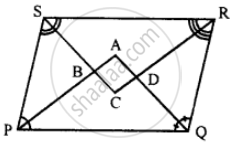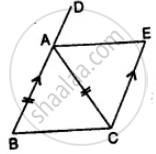Advertisements
Advertisements
Question
Can a quadrilateral ABCD be a parallelogram if ∠D + ∠B = 180°?
Solution
For ∠D + ∠B = 180°, quadrilateral ABCD may or may not be a parallelogram. Along with this condition, the following conditions should also be fulfilled.
The sum of the measures of adjacent angles should be 180º.
Opposite angles should also be of same measures.
APPEARS IN
RELATED QUESTIONS
Two adjacent angles of a parallelogram have equal measure. Find the measure of each of the angles of the parallelogram.
The adjacent figure HOPE is a parallelogram. Find the angle measures x, y and z. State the properties you use to find them.

In the adjacent figure, if seg AB || seg PQ, seg AB ≅ seg PQ, seg AC || seg PR, seg AC ≅ seg PR then prove that, seg BC || seg QR and seg BC ≅ seg QR.

Ratio of consecutive angles of a quadrilateral is 1 : 2 : 3 : 4. Find the measure of its each angle. Write, with reason, what type of a quadrilateral it is.
In parallelogram ABCD, ∠A = 3 times ∠B. Find all the angles of the parallelogram. In the same parallelogram, if AB = 5x – 7 and CD = 3x +1 ; find the length of CD.
Prove that the diagonals of a parallelogram bisect each other.
In the following diagram, the bisectors of interior angles of the parallelogram PQRS enclose a quadrilateral ABCD.

Show that:
(i) ∠PSB + ∠SPB = 90°
(ii) ∠PBS = 90°
(iii) ∠ABC = 90°
(iv) ∠ADC = 90°
(v) ∠A = 90°
(vi) ABCD is a rectangle
Thus, the bisectors of the angles of a parallelogram enclose a rectangle.
In the given figure, AB || EC, AB = AC and AE bisects ∠DAC. Prove that:

- ∠EAC = ∠ACB
- ABCE is a parallelogram.
The adjacent sides of a parallelogram are 5 cm and 9 cm. Its perimeter is ______.
Construct a parallelogram when one of its side is 4 cm and its two diagonals are 5.6 cm and 7 cm. Measure the other side.
